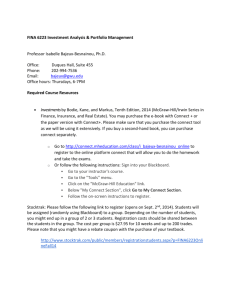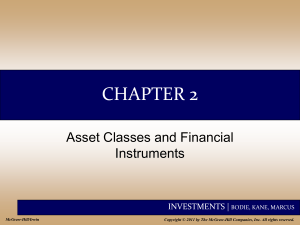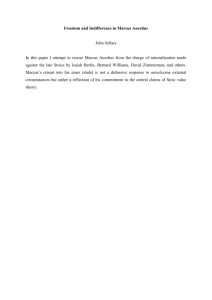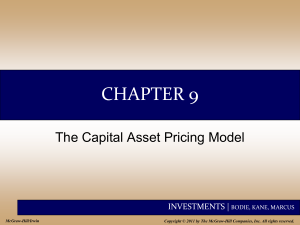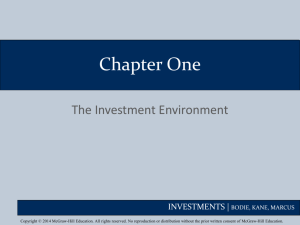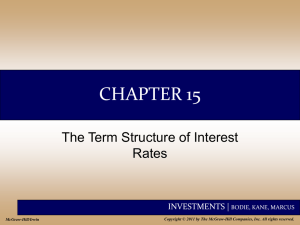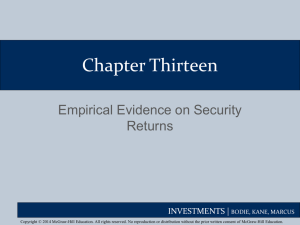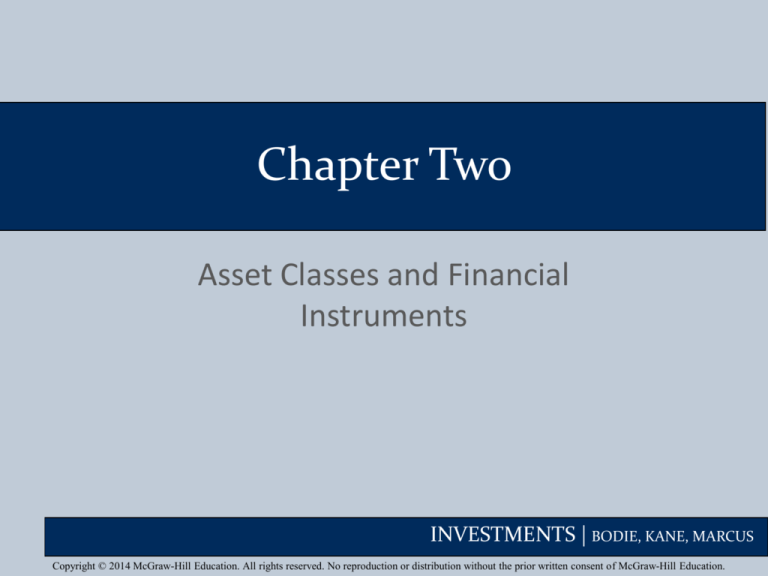
Chapter Two
Asset Classes and Financial
Instruments
INVESTMENTS | BODIE, KANE, MARCUS
Copyright © 2014 McGraw-Hill Education. All rights reserved. No reproduction or distribution without the prior written consent of McGraw-Hill Education.
Chapter Overview
Asset allocation → Asset classes
•Money markets vs. capital markets
•Types of money market instruments
•Capital market securities:
• Bonds
• Equity
• Derivatives
2-2
INVESTMENTS | BODIE, KANE, MARCUS
The Money Market
• Subsector of the fixed-income market:
Securities are short-term, liquid, low risk, and
often have large denominations
• Money market mutual funds allow individuals
to access the money market
2-3
INVESTMENTS | BODIE, KANE, MARCUS
Table 2.1 Major Components of
the Money Market
2-4
INVESTMENTS | BODIE, KANE, MARCUS
Money Market Securities
• Treasury bills: Short-term debt of U.S. government
• Bid and asked price
• Bank discount yield vs Effective annual yield
• Bank discount yield vs Bond equivalent yield
• Competitive vs Noncompetitive bid
• Certificates of deposit: Time deposit with a bank
• Commercial paper: Short-term, unsecured debt of a
company
2-5
INVESTMENTS | BODIE, KANE, MARCUS
Money Market Securities
• Bankers’ Acceptances: An order to a bank by a
bank’s customer to pay a sum of money on a
future date
• Eurodollars: Dollar-denominated time
deposits in banks outside the U.S.
• Repos and reverses: Short-term loan backed
by government securities.
• Fed funds: Very short-term loans between
banks
2-6
INVESTMENTS | BODIE, KANE, MARCUS
Yields on Money Market Instruments
• Except for Treasury bills, money market
securities are not free of default risk
• Both the premium on bank CDs and the TED
spread have often become greater during
periods of financial crisis
• During the credit crisis of 2008, the federal
government offered insurance to money
market mutual funds after some funds
experienced losses
2-7
INVESTMENTS | BODIE, KANE, MARCUS
The Bond Market
•
•
•
•
•
•
•
2-8
Treasury Notes and Bonds
Inflation-Protected Treasury Bonds
Federal Agency Debt
International Bonds
Municipal Bonds
Corporate Bonds
Mortgages and Mortgage-Backed Securities
INVESTMENTS | BODIE, KANE, MARCUS
Bond Market Securities
• Treasury Notes and Bonds
• Maturities
• Notes – Maturities up to 10 years
• Bonds – Maturities from 10 to 30 years
• Par Value - $1,000
• Interest paid semiannually
• Quotes – Percentage of par
2-9
INVESTMENTS | BODIE, KANE, MARCUS
Bond Market Securities
• Inflation-Protected Treasury Bonds
• TIPS: Provide inflation protection
• Federal Agency Debt
• Debt of mortgage-related agencies such as Fannie
Mae and Freddie Mac
• International Bonds
• Eurobonds and Yankee bonds
2-10
INVESTMENTS | BODIE, KANE, MARCUS
Bond Market Securities
• Municipal Bonds
• Issued by state and local governments
• Interest is exempt from federal income tax and
sometimes from state and local tax
• Types
• General obligation bonds: Backed by taxing power
of issuer
• Revenue bonds: backed by project’s revenues or by
the municipal agency operating the project.
2-11
INVESTMENTS | BODIE, KANE, MARCUS
Figure 2.4 Tax-Exempt Debt
Outstanding
3,000
Industrial revenue bonds
2,500
General obligation
$ Billion
2,000
1,500
1,000
500
2-12
2012
2011
2010
2009
2008
2007
2006
2005
2004
2003
2002
2001
2000
1999
1998
1997
1996
1995
1994
1993
1992
1991
1990
1989
1988
1987
1986
1985
1984
1983
1982
1981
1980
1979
0
INVESTMENTS | BODIE, KANE, MARCUS
Municipal Bond Yields
• To choose between taxable and tax-exempt
bonds, compare after-tax returns on each
bond.
• Let t equal the investor’s marginal tax bracket
• Let r equal the before-tax return on the taxable
bond and rm denote the municipal bond rate.
• If r(1 - t ) > rm, then the taxable bond gives a
higher return; otherwise, the municipal bond is
preferred.
2-13
INVESTMENTS | BODIE, KANE, MARCUS
Table 2.2 Tax-Exempt Yield Table
The equivalent taxable yield is simply the taxfree rate, rm, divided by (1 - t).
2-14
INVESTMENTS | BODIE, KANE, MARCUS
Bond Market Securities
• Corporate Bonds
• Issued by private firms
• Semi-annual interest payments
• Subject to larger default risk than government
securities
• Options in corporate bonds
• Callable
• Convertible
2-15
INVESTMENTS | BODIE, KANE, MARCUS
Bond Market Securities
• Mortgage-Backed Securities
• Proportional ownership of a mortgage pool or a
specified obligation secured by a pool
• Produced by securitizing mortgages
• Mortgage-backed securities are called passthroughs because the cash flows produced by
homeowners paying off their mortgages are passed
through to investors.
• Most were issued by Fannie Mae and Freddie Mac
2-16
INVESTMENTS | BODIE, KANE, MARCUS
Bond Market Securities
• Mortgage-Backed Securities
• Traditionally, were comprised of conforming
mortgages, which met standards of credit
worthiness
• Later on, “Private-label” issuers securitized large
amounts of subprime mortgages, made to
financially weak borrowers
• Fannie and Freddie were allowed and even
encouraged to buy subprime mortgage securities
2-17
INVESTMENTS | BODIE, KANE, MARCUS
Figure 2.6 Mortgage-Backed Securities
Outstanding
8,000
7,000
Private issuers
Federal agencies
$ Billions
6,000
5,000
4,000
3,000
2,000
1,000
2-18
2012
2009
2006
2003
2000
1997
1994
1991
1988
1985
1982
1979
0
INVESTMENTS | BODIE, KANE, MARCUS
Equity Securities
• Common stock: Ownership
• Residual claim
• Limited liability
• Preferred stock: Perpetuity
• Fixed dividends
• Priority over common
• Tax treatment
• American Depository Receipts
• Certificates traded in U.S. markets that represent
ownership in shares of a foreign company
2-19
INVESTMENTS | BODIE, KANE, MARCUS
Stock Market Indexes
• Dow Jones Industrial Average
• Includes 30 large blue-chip corporations
• Computed since 1896
• Price-weighted average
2-20
INVESTMENTS | BODIE, KANE, MARCUS
Example 2.2 Price-Weighted Average
Portfolio: Initial value $25 + $100 = $125
Final value $30 + $90 = $120
Percentage change in portfolio value
= 5/125 = -.04 = -4%
Index:
2-21
Initial index value (25+100)/2 = 62.5
Final index value (30 + 90)/2 = 60
Percentage change in index -2.5/62.5
= -.04 = -4%
INVESTMENTS | BODIE, KANE, MARCUS
Stock Market Indexes
• Standard & Poor’s 500
• Broadly based index of 500 firms
• Market-value-weighted index
• Investors can base their portfolios on an index
• Buy an index mutual fund
• Buy exchange traded funds (ETFs)
2-22
INVESTMENTS | BODIE, KANE, MARCUS
Other Indexes
2-23
U.S. Indexes
Foreign Indexes
• NYSE Composite
• NASDAQ Composite
• Wilshire 5000
• Nikkei (Japan)
• FTSE (U.K.; pronounced
“footsie”)
• DAX (Germany),
• Hang Seng (Hong Kong)
• TSX (Canada)
INVESTMENTS | BODIE, KANE, MARCUS
Derivatives Markets
• A derivative is a security that gets its value
from the values of another asset, such as
commodity prices, bond and stock prices, or
market index values
2-24
INVESTMENTS | BODIE, KANE, MARCUS
Derivatives Markets
• Options
• Call: Right to buy underlying asset at the strike or
exercise price
• Value of calls decreases as strike price increases
• Put: Right to sell underlying asset at the strike or
exercise price
• Value of puts increase with strike price
• Value of both calls and puts increases with time
until expiration
2-25
INVESTMENTS | BODIE, KANE, MARCUS
Derivatives Markets
• Futures Contracts
• An agreement made today regarding the delivery
of an asset (or in some cases, its cash value) at a
specified delivery or maturity date for an agreedupon price, called the futures price, to be paid at
contract maturity
• Long position: Take delivery at maturity
• Short position: Make delivery at maturity
2-26
INVESTMENTS | BODIE, KANE, MARCUS
Comparison
2-27
Option
Futures Contract
• Right, but not obligation,
to buy or sell; option is
exercised only when it is
profitable
• Options must be
purchased
• The premium is the price
of the option itself.
• Obliged to make or take
delivery; long position
must buy at the futures
price, short position must
sell at futures price
• Futures contracts are
entered into without cost
INVESTMENTS | BODIE, KANE, MARCUS


